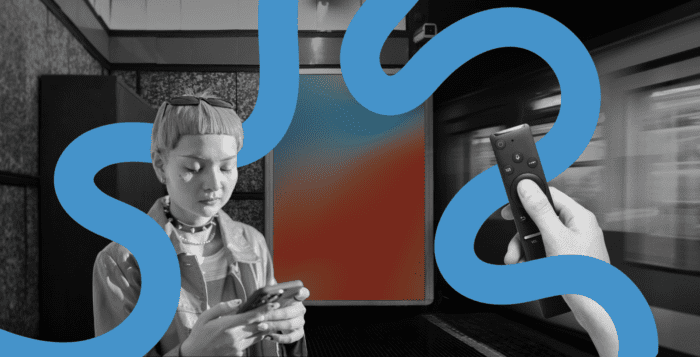Understanding the Differences And What It Means for Brands
Media habits are constantly evolving, but generational differences remain one of the clearest indicators of how people consume content. When it comes to Gen Z and Millennials, the contrast is especially stark—from preferred platforms to content formats and trust drivers. Understanding these distinctions can help brands engage more effectively, and authentically, with each group.
TL;DR:
| Category | Gen Z | Millennials |
| Favorite Platforms | TikTok, Instagram, YouTube, Reddit, BeReal | Instagram, Facebook, YouTube, Pinterest |
| Content Style | Short, visual, authentic | Informative, polished, long-form |
| Influencer Trust | High (peers/creators) | Medium (experts/peers) |
| Preferred Device | Mobile-first | Mobile + Desktop |
| Audio Habits | Spotify, YouTube | Spotify, YouTube + Podcasts & Radio |
| Streaming Habits | All-mobile, short-form | Mixed formats, longer-form |
| OOH Perception | Cool, action-inducing | Seen, but less influential |
Platforms They Prefer
Gen Z (born ~1997–2012) is a mobile-native generation. They’ve grown up swiping, tapping, and scrolling—so it’s no surprise that TikTok, Instagram, and YouTube dominate their media diet. Gen Z prefers short, visual, and unfiltered content. They’re all about entertainment and authenticity—highly produced ads don’t perform as well here.
You’ll also find Gen Z experimenting with emerging platforms like BeReal, and browsing Reddit more frequently than older users. Pinterest also sees strong engagement from this cohort, despite often being seen as a millennial playground.
Millennials (born ~1981–1996) use many of the same platforms—Instagram, YouTube—but their presence is still strong on Facebook and Twitter/X. They’re more likely to consume long-form content, subscribe to email newsletters, and follow traditional news sources. Millennials are also more likely to access content from both mobile and desktop, creating a wider window for brand touchpoints.
Quick stat check:
• Gen Z spends 3+ hours/day on social media, with TikTok as their top app.
• Millennials tend to multitask—streaming video while browsing or listening to podcasts.
How They Discover Brands
Gen Z is discovery-driven through social media—especially via creators and influencers. They trust peer recommendations and trends on TikTok or YouTube over traditional ads. Micro- and nano-influencers are especially powerful here. Gen Z also sees DOOH (digital out-of-home) advertising as a “cool” format and is more likely to take action after seeing it (Vividata, 2025).
Millennials are more research-oriented. They still value peer input, but also look for expert opinions, in-depth reviews, and comparisons before buying. They’ll click on that newsletter, read the full blog post, and dig into the FAQs.
Content That Converts
Gen Z: Bite-sized, bold, and scroll-stopping. Think memes, 6-second TikToks, trending audio, or punchy product demos. Anything that feels like an ad is likely to be skipped.
Millennials: They want value. They’ll sit through a well-produced YouTube video, attend a webinar, or save a carousel post that breaks down a topic in a meaningful way.
Streaming, Audio & Traditional Media
Both generations have moved far from cable TV, but the details differ.
Gen Z is all-in on streaming—especially on mobile. They’re watching YouTube, Netflix, or TikTok clips more than traditional shows. And they prefer creators over celebrities as entertainment leaders.
Millennials also stream heavily, but they’re more likely to have a mix of subscriptions (Netflix, Prime), and yes—even a cable login. They’re also more frequent podcast listeners (Vividata, 2025) and tune into traditional radio more often than Gen Z.
Both groups stream music constantly, with Spotify and YouTube leading the way. But podcasts and radio set Millennials apart in the audio game.
Out-of-Home Advertising
This might surprise some marketers: Both generations pay attention to out-of-home ads, but Gen Z sees DOOH as a modern, eye-catching format. According to Vividata (2025), Gen Z is also more likely to take action after seeing a DOOH ad, while Millennials see it more as background media.
What This Means for Marketers
Understanding the nuances of how Gen Z and Millennials consume media is crucial for optimizing campaign strategy, creative formats, and messaging. Here’s how to tailor your approach:
If you’re targeting Gen Z:
- Prioritize authentic, creator-led content
- Invest in short-form video and mobile-optimized creative
- Explore platforms like TikTok, Reddit, and BeReal
- Embrace bold visuals and trending formats
- Consider DOOH for awareness—Gen Z notices
If you’re targeting Millennials:
- Offer substance-driven content across multiple platforms
- Use email marketing, blog content, and podcasts
- Mix expert voices with peer recommendations
- Don’t ignore Facebook and Pinterest
- Leverage both mobile and desktop experiences
In today’s fragmented media landscape, one-size-fits-all just doesn’t work. Whether you’re crafting a viral TikTok or a detailed white paper, the key is knowing your audience—and meeting them where they are, in the format they love.
Looking for expert help? Reach out.
